On the Mixed Gas Behavior of Organosilica Membranes Fabricated by Plasma-Enhanced Chemical Vapor Deposition (PECVD)
Abstract
1. Introduction
2. Experimental
2.1. Materials
2.2. PECVD Membrane Fabrication
2.3. XPS Measurements
2.4. FTIR Measurements
2.5. Ellipsometry Measurements
2.6. Permeation Measurements
3. Results and Discussion
3.1. Chemical Analysis of the Organosilica Layer
3.2. Temperature-Dependent Permeation Behavior
3.3. Mixed Gas Behavior
3.3.1. Permanent Gases
3.3.2. Condensable Gases
3.3.3. Water Vapor
4. Conclusions
Author Contributions
Funding
Institutional Review Board Statement
Informed Consent Statement
Data Availability Statement
Conflicts of Interest
Abbreviations
| αi/j | Membrane selectivity of gas i to gas j |
| CEM | Controlled evaporator and mixing device |
| CH4 | Methane |
| CO2 | Carbon dioxide |
| GC | Gas chromatograph |
| GPS | Gas permeation setup |
| GPU | Gas permeation unit |
| He | Helium |
| HMDSO | Hexamethyldisiloxane |
| MFC | Mass flow controller |
| MOF | Metal organic framework |
| N2 | Nitrogen |
| PAN | Polyacrylonitrile |
| PDMS | Polydimethylsiloxane |
| PECVD | Plasma-enhanced chemical vapor deposition |
| T | Temperature (°C) |
| TDP | dew point temperature (°C) |
| P | Pressure (bar) |
| XPS | X-ray photoelectron spectroscopy |
References
- Masson-Delmotte, V.; Zhai, P.; Pörtner, H.O.; Roberts, D.; Skea, J.; Shukla, P.R.; Pirani, A.; Moufouma-Okia, W.; Péan, C.; Pidcock, R.; et al. Global warming of 1.5 °C. IPCC Spec. Rep. Impacts Glob. Warm. 2018, 1, 1–36. [Google Scholar]
- Brunetti, A.; Bernardo, P.; Drioli, E.; Barbieri, G.; Yampolskii, Y.; Freeman, B. Membrane engineering: Progress and potentialities in gas separations. Membr. Gas Sep. 2010, 6, 279–312. [Google Scholar]
- Sholl, D.S.; Lively, R.P. Seven chemical separations to change the world. Nature 2016, 532, 435–437. [Google Scholar] [CrossRef] [PubMed]
- Robeson, L.M. The upper bound revisited. J. Membr. Sci. 2008, 320, 390–400. [Google Scholar] [CrossRef]
- Swaidan, R.; Ghanem, B.; Pinnau, I. Fine-tuned intrinsically ultramicroporous polymers redefine the permeability/selectivity upper bounds of membrane-based air and hydrogen separations. ACS Macro Lett. 2015, 4, 947–951. [Google Scholar] [CrossRef] [PubMed]
- Comesaña-Gándara, B.; Chen, J.; Bezzu, C.G.; Carta, M.; Rose, I.; Ferrari, M.C.; Esposito, E.; Fuoco, A.; Jansen, J.C.; McKeown, N.B. Redefining the Robeson upper bounds for CO2/CH4 and CO2/N2 separations using a series of ultrapermeable benzotriptycene-based polymers of intrinsic microporosity. Energy Environ. Sci. 2019, 12, 2733–2740. [Google Scholar] [CrossRef]
- Lai, H.W.; Benedetti, F.M.; Ahn, J.M.; Robinson, A.M.; Wang, Y.; Pinnau, I.; Smith, Z.P.; Xia, Y. Hydrocarbon ladder polymers with ultrahigh permselectivity for membrane gas separations. Science 2022, 375, 1390–1392. [Google Scholar] [CrossRef] [PubMed]
- Iulianelli, A.; Drioli, E. Membrane engineering: Latest advancements in gas separation and pre-treatment processes, petrochemical industry and refinery, and future perspectives in emerging applications. Fuel Process. Technol. 2020, 206, 106464. [Google Scholar] [CrossRef]
- Scholes, C.A.; Gosh, U.K.; Ho, M.T. The economics of helium separation and purification by gas separation membranes. Ind. Eng. Chem. Res. 2017, 56, 5014–5020. [Google Scholar] [CrossRef]
- Alders, M.; Winterhalder, D.; Wessling, M. Helium recovery using membrane processes. Sep. Purif. Technol. 2017, 189, 433–440. [Google Scholar] [CrossRef]
- Scholes, C.A.; Ghosh, U. Helium separation through polymeric membranes: Selectivity targets. J. Membr. Sci. 2016, 520, 221–230. [Google Scholar] [CrossRef]
- Sunarso, J.; Hashim, S.S.; Lin, Y.; Liu, S. Membranes for helium recovery: An overview on the context, materials and future directions. Sep. Purif. Technol. 2017, 176, 335–383. [Google Scholar] [CrossRef]
- Scholes, C.A.; Ghosh, U.K. Review of membranes for helium separation and purification. Membranes 2017, 7, 9. [Google Scholar] [CrossRef]
- Roualdes, S.; Rouessac, V.; Durand, J. Plasma Membranes. 2010. [Google Scholar]
- Li, K.; Meichsner, J. Gas-separating properties of membranes coated by HMDSO plasma polymer. Surf. Coat. Technol. 1999, 116, 841–847. [Google Scholar] [CrossRef]
- Roualdes, S.; Rouessac, V. 1.10 Plasma Membranes. In Comprehensive Membrane Science and Engineering; Elsevier: Amsterdam, The Netherlands, 2017; pp. 236–269. [Google Scholar]
- Lo, C.H.; Lin, M.H.; Liao, K.S.; De Guzman, M.; Tsai, H.A.; Rouessac, V.; Wei, T.C.; Lee, K.R.; Lai, J.Y. Control of pore structure and characterization of plasma-polymerized SiOCH films deposited from octamethylcyclotetrasiloxane (OMCTS). J. Membr. Sci. 2010, 365, 418–425. [Google Scholar] [CrossRef]
- Kafrouni, W.; Rouessac, V.; Julbe, A.; Durand, J. Synthesis and characterization of silicon carbonitride films by plasma enhanced chemical vapor deposition (PECVD) using bis (dimethylamino) dimethylsilane (BDMADMS), as membrane for a small molecule gas separation. Appl. Surf. Sci. 2010, 257, 1196–1203. [Google Scholar] [CrossRef]
- Coustel, R.; Haacké, M.; Rouessac, V.; Durand, J.; Drobek, M.; Julbe, A. An insight into the structure–property relationships of PECVD SiCxNy (O): H materials. Microporous Mesoporous Mater. 2014, 191, 97–102. [Google Scholar] [CrossRef]
- Nagasawa, H.; Minamizawa, T.; Kanezashi, M.; Yoshioka, T.; Tsuru, T. Microporous organosilica membranes for gas separation prepared via PECVD using different O/Si ratio precursors. J. Membr. Sci. 2015, 489, 11–19. [Google Scholar] [CrossRef]
- Kleines, L.; Jaritz, M.; Wilski, S.; Rubner, J.; Alders, M.; Wessling, M.; Hopmann, C.; Dahlmann, R. Enhancing the separation properties of plasma polymerized membranes on polydimethylsiloxane substrates by adjusting the auxiliary gas in the PECVD processes. J. Phys. D Appl. Phys. 2020, 53, 445301. [Google Scholar] [CrossRef]
- Kleines, L.; Wilski, S.; Alizadeh, P.; Rubner, J.; Wessling, M.; Hopmann, C.; Dahlmann, R. Structure and gas separation properties of ultra-smooth PE-CVD silicon organic coated composite membranes. Surf. Coat. Technol. 2021, 421, 127338. [Google Scholar] [CrossRef]
- Kleines, L.; Wilski, S.; Alizadeh, P.; Rubner, J.; Wessling, M.; Hopmann, C.; Dahlmann, R. Evaluation of the membrane performance of ultra-smooth silicon organic coatings depending on the process energy density. Thin Solid Films 2022, 748, 139169. [Google Scholar] [CrossRef]
- Kafrouni, W.; Rouessac, V.; Julbe, A.; Durand, J. Synthesis of PECVD a-SiCXNY: H membranes as molecular sieves for small gas separation. J. Membr. Sci. 2009, 329, 130–137. [Google Scholar] [CrossRef]
- Tsuru, T.; Shigemoto, H.; Kanezashi, M.; Yoshioka, T. 2-Step plasma-enhanced CVD for low-temperature fabrication of silica membranes with high gas-separation performance. Chem. Commun. 2011, 47, 8070–8072. [Google Scholar] [CrossRef]
- Nagasawa, H.; Shigemoto, H.; Kanezashi, M.; Yoshioka, T.; Tsuru, T. Characterization and gas permeation properties of amorphous silica membranes prepared via plasma enhanced chemical vapor deposition. J. Membr. Sci. 2013, 441, 45–53. [Google Scholar] [CrossRef]
- Haacké, M.; Coustel, R.; Rouessac, V.; Drobek, M.; Roualdès, S.; Julbe, A. Optimization of the molecular sieving properties of amorphous SiC XNY: H hydrogen selective membranes prepared by PECVD. Eur. Phys. J. Spec. Top. 2015, 224, 1935–1943. [Google Scholar] [CrossRef]
- Roualdes, S.; Van der Lee, A.; Berjoan, R.; Sanchez, J.; Durand, J. Gas separation properties of organosilicon plasma polymerized membranes. AIChE J. 1999, 45, 1566–1575. [Google Scholar] [CrossRef]
- Roualdes, S.; Sanchez, J.; Durand, J. Gas diffusion and sorption properties of polysiloxane membranes prepared by PECVD. J. Membr. Sci. 2002, 198, 299–310. [Google Scholar] [CrossRef]
- Bosc, F.; Sanchez, J.; Rouessac, V.; Durand, J. Sorption and permeation characteristics of hybrid organosilicon thin films deposited by PECVD. Sep. Purif. Technol. 2003, 32, 371–376. [Google Scholar] [CrossRef]
- Ngamou, P.H.; Overbeek, J.P.; Kreiter, R.; van Veen, H.M.; Vente, J.F.; Wienk, I.M.; Cuperus, P.F.; Creatore, M. Plasma-deposited hybrid silica membranes with a controlled retention of organic bridges. J. Mater. Chem. A 2013, 1, 5567–5576. [Google Scholar] [CrossRef]
- Charifou, R.; Espuche, E.; Gouanvé, F.; Dubost, L.; Monaco, B. SiOx and SiOxCzHw mono-and multi-layer deposits for improved polymer oxygen and water vapor barrier properties. J. Membr. Sci. 2016, 500, 245–254. [Google Scholar] [CrossRef]
- Wang, M.; Boscher, N.D.; Heinze, K.; Gleason, K.K. Gas selective ultrathin organic covalent networks synthesized by iPECVD: Does the central metal ion matter? Adv. Funct. Mater. 2017, 27, 1606652. [Google Scholar] [CrossRef]
- Izu, M.; Dotter, B.; Ovshinsky, S. Roll-to-roll microwave PECVD machine for high-barrier film coatings. J. Photopolym. Sci. Technol. 1995, 8, 195–204. [Google Scholar] [CrossRef]
- Zhu, L.; Huang, L.; Venna, S.R.; Blevins, A.K.; Ding, Y.; Hopkinson, D.P.; Swihart, M.T.; Lin, H. Scalable Polymeric Few-Nanometer Organosilica Membranes with Hydrothermal Stability for Selective Hydrogen Separation. ACS Nano 2021, 15, 12119–12128. [Google Scholar] [CrossRef]
- Guiver, M.D.; Robertson, G.P.; Dai, Y.; Bilodeau, F.; Kang, Y.S.; Lee, K.J.; Jho, J.Y.; Won, J. Structural characterization and gas-transport properties of brominated matrimid polyimide. J. Polym. Sci. Part A Polym. Chem. 2002, 40, 4193–4204. [Google Scholar] [CrossRef]
- Shen, Y.; Lua, A.C. Effects of membrane thickness and heat treatment on the gas transport properties of membranes based on P84 polyimide. J. Appl. Polym. Sci. 2010, 116, 2906–2912. [Google Scholar] [CrossRef]
- Nagasawa, H.; Kanezashi, M.; Yoshioka, T.; Tsuru, T. Plasma-enhanced chemical vapor deposition of amorphous carbon molecular sieve membranes for gas separation. RSC Adv. 2016, 6, 59045–59049. [Google Scholar] [CrossRef]
- Gavalas, G.; Megiris, C.; Nam, S. Deposition of H2-permselective SiO2 films. Chem. Eng. Sci. 1989, 44, 1829–1835. [Google Scholar] [CrossRef]
- Gallaher, G.; Liu, P. Characterization of ceramic membranes I. Thermal and hydrothermal stabilities of commercial 40 Å membranes. J. Membr. Sci. 1994, 92, 29–44. [Google Scholar] [CrossRef]
- Leboda, R.; Mendyk, E.; Gierak, A.; Tertykh, V. Hydrothermal modification of silica gels (xerogels) 2. Effect of the duration of treatment on their porous structure. Colloids Surf. Physicochem. Eng. Asp. 1995, 105, 191–197. [Google Scholar] [CrossRef]
- Duke, M.C.; Da Costa, J.D.; Do, D.D.; Gray, P.G.; Lu, G.Q. Hydrothermally robust molecular sieve silica for wet gas separation. Adv. Funct. Mater. 2006, 16, 1215–1220. [Google Scholar] [CrossRef]
- Castricum, H.L.; Sah, A.; Kreiter, R.; Blank, D.H.; Vente, J.F.; Johan, E. Hydrothermally stable molecular separation membranes from organically linked silica. J. Mater. Chem. 2008, 18, 2150–2158. [Google Scholar] [CrossRef]
- Song, H.; Zhao, S.; Lei, J.; Wang, C.; Qi, H. Pd-doped organosilica membrane with enhanced gas permeability and hydrothermal stability for gas separation. J. Mater. Sci. 2016, 51, 6275–6286. [Google Scholar] [CrossRef]
- Jaritz, M.; Hopmann, C.; Wilski, S.; Kleines, L.; Rudolph, M.; Awakowicz, P.; Dahlmann, R. HMDSO-based thin plasma polymers as corrosion barrier against NaOH solution. J. Mater. Eng. Perform. 2020, 29, 2839–2847. [Google Scholar] [CrossRef]
- Herzinger, C.; Johs, B.; McGahan, W.; Woollam, J.A.; Paulson, W. Ellipsometric determination of optical constants for silicon and thermally grown silicon dioxide via a multi-sample, multi-wavelength, multi-angle investigation. J. Appl. Phys. 1998, 83, 3323–3336. [Google Scholar] [CrossRef]
- Logemann, M.; Alders, M.; Pyankova, V.; Krakau, D.; Wessling, M. How is mixed-gas permeation through poly(1-trimethylsilyl-1-propyne) membranes influenced by elevated temperatures? J. Membr. Sci. 2020, 615, 118430. [Google Scholar] [CrossRef]
- Antoine, M.C. Nouvelle relation entre les tensions et les temperatures. C. R. Held Seanc. Acad. Sci. Paris 1888, 107, 681–684. [Google Scholar]
- Yasuda, H.; Hsu, T. Some aspects of plasma polymerization investigated by pulsed RF discharge. J. Polym. Sci. Polym. Chem. Ed. 1977, 15, 81–97. [Google Scholar] [CrossRef]
- Grill, A.; Neumayer, D.A. Structure of low dielectric constant to extreme low dielectric constant SiCOH films: Fourier transform infrared spectroscopy characterization. J. Appl. Phys. 2003, 94, 6697–6707. [Google Scholar] [CrossRef]
- Lenza, R.F.; Vasconcelos, W.L. Structural evolution of silica sols modified with formamide. Mater. Res. 2001, 4, 175–179. [Google Scholar] [CrossRef]
- Mota, R.P.; Galvão, D.; Durrant, S.F.; De Moraes, M.A.B.; de Oliveira Dantas, S.; Cantão, M. HMDSO plasma polymerization and thin film optical properties. Thin Solid Film. 1995, 270, 109–113. [Google Scholar] [CrossRef]
- Efimenko, K.; Wallace, W.E.; Genzer, J. Surface modification of Sylgard-184 poly(dimethyl siloxane) networks by ultraviolet and ultraviolet/ozone treatment. J. Colloid Interface Sci. 2002, 254, 306–315. [Google Scholar] [CrossRef]
- Khorasani, M.; Mirzadeh, H.; Sammes, P. Laser induced surface modification of polydimethylsiloxane as a super-hydrophobic material. Radiat. Phys. Chem. 1996, 47, 881–888. [Google Scholar] [CrossRef]
- Breck, D.W.; Breck, D.W. Zeolite Molecular Sieves: Structure, Chemistry, and Use; John Wiley & Sons: Hoboken, NJ, USA, 1973. [Google Scholar]
- Kihara, T. The second virial coefficient of non-spherical molecules. J. Phys. Soc. Jpn. 1951, 6, 289–296. [Google Scholar] [CrossRef]
- Bos, A.; Pünt, I.; Wessling, M.; Strathmann, H. CO2-induced plasticization phenomena in glassy polymers. J. Membr. Sci. 1999, 155, 67–78. [Google Scholar] [CrossRef]
- Visser, T.; Koops, G.; Wessling, M. On the subtle balance between competitive sorption and plasticization effects in asymmetric hollow fiber gas separation membranes. J. Membr. Sci. 2005, 252, 265–277. [Google Scholar] [CrossRef]
- Visser, T.; Masetto, N.; Wessling, M. Materials dependence of mixed gas plasticization behavior in asymmetric membranes. J. Membr. Sci. 2007, 306, 16–28. [Google Scholar] [CrossRef]
- Ricci, E.; Benedetti, F.M.; Dose, M.E.; De Angelis, M.G.; Freeman, B.D.; Paul, D.R. Competitive sorption in CO2/CH4 separations: The case of HAB-6FDA polyimide and its TR derivative and a general analysis of its impact on the selectivity of glassy polymers at multicomponent conditions. J. Membr. Sci. 2020, 612, 118374. [Google Scholar] [CrossRef]
- Genduso, G.; Ghanem, B.S.; Pinnau, I. Experimental mixed-gas permeability, sorption and diffusion of CO2-CH4 mixtures in 6FDA-mPDA polyimide membrane: Unveiling the effect of competitive sorption on permeability selectivity. Membranes 2019, 9, 10. [Google Scholar] [CrossRef]
- Vopička, O.; De Angelis, M.G.; Sarti, G.C. Mixed gas sorption in glassy polymeric membranes: I. CO2/CH4 and n-C4/CH4 mixtures sorption in poly(1-trimethylsilyl-1-propyne) (PTMSP). J. Membr. Sci. 2014, 449, 97–108. [Google Scholar] [CrossRef]
- De Vos, R.M.; Verweij, H. High-selectivity, high-flux silica membranes for gas separation. Science 1998, 279, 1710–1711. [Google Scholar] [CrossRef]
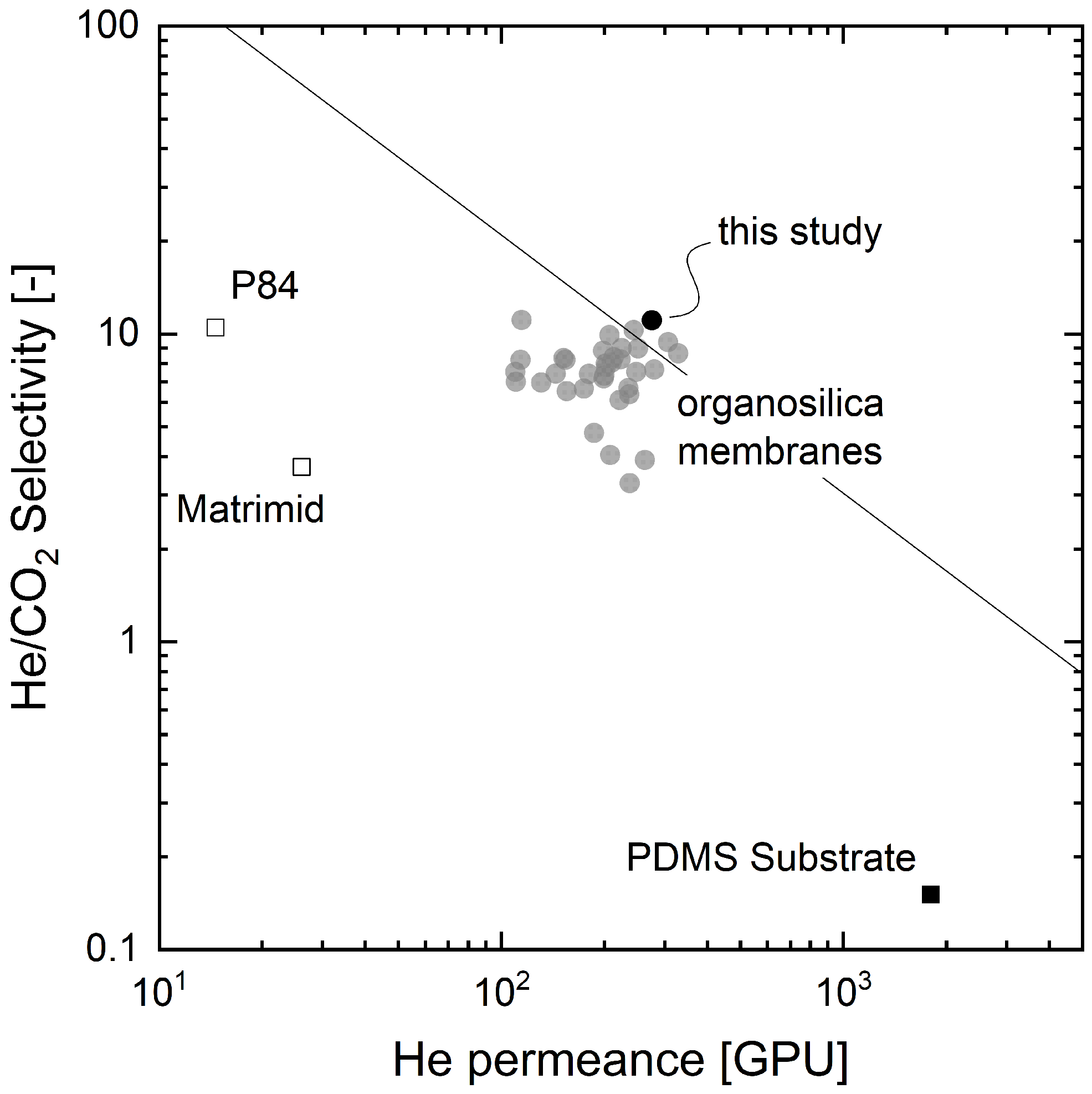
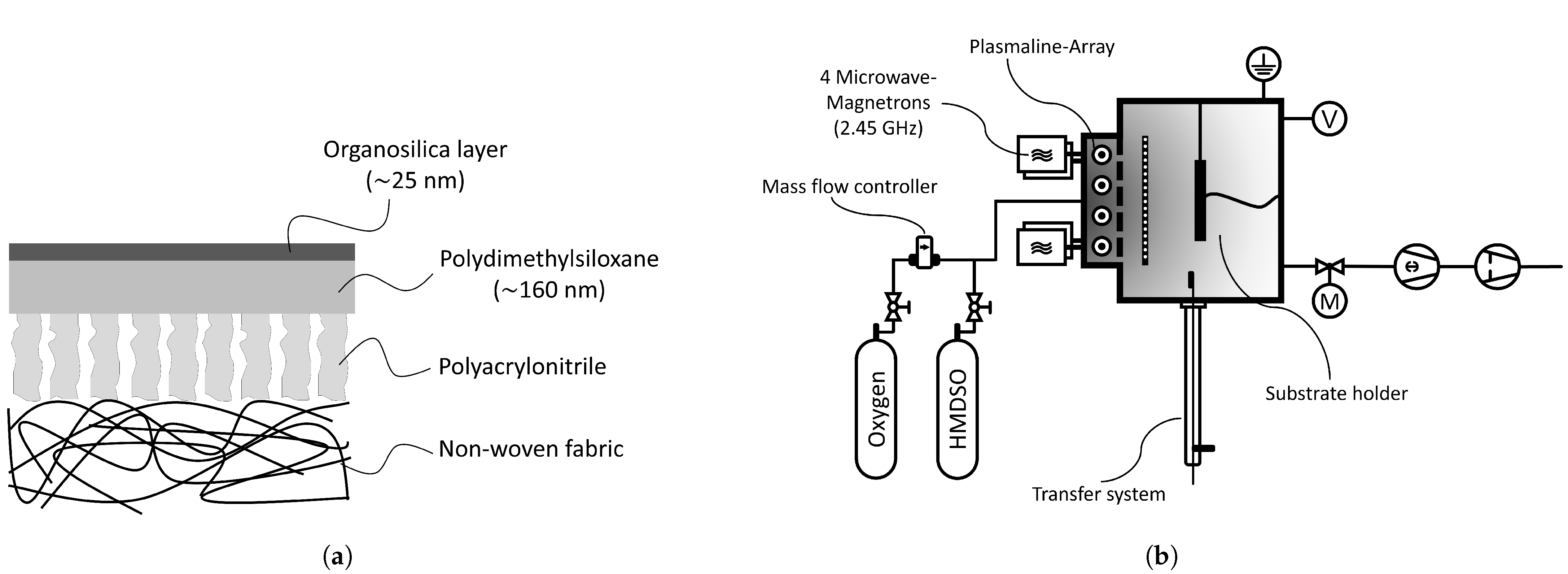
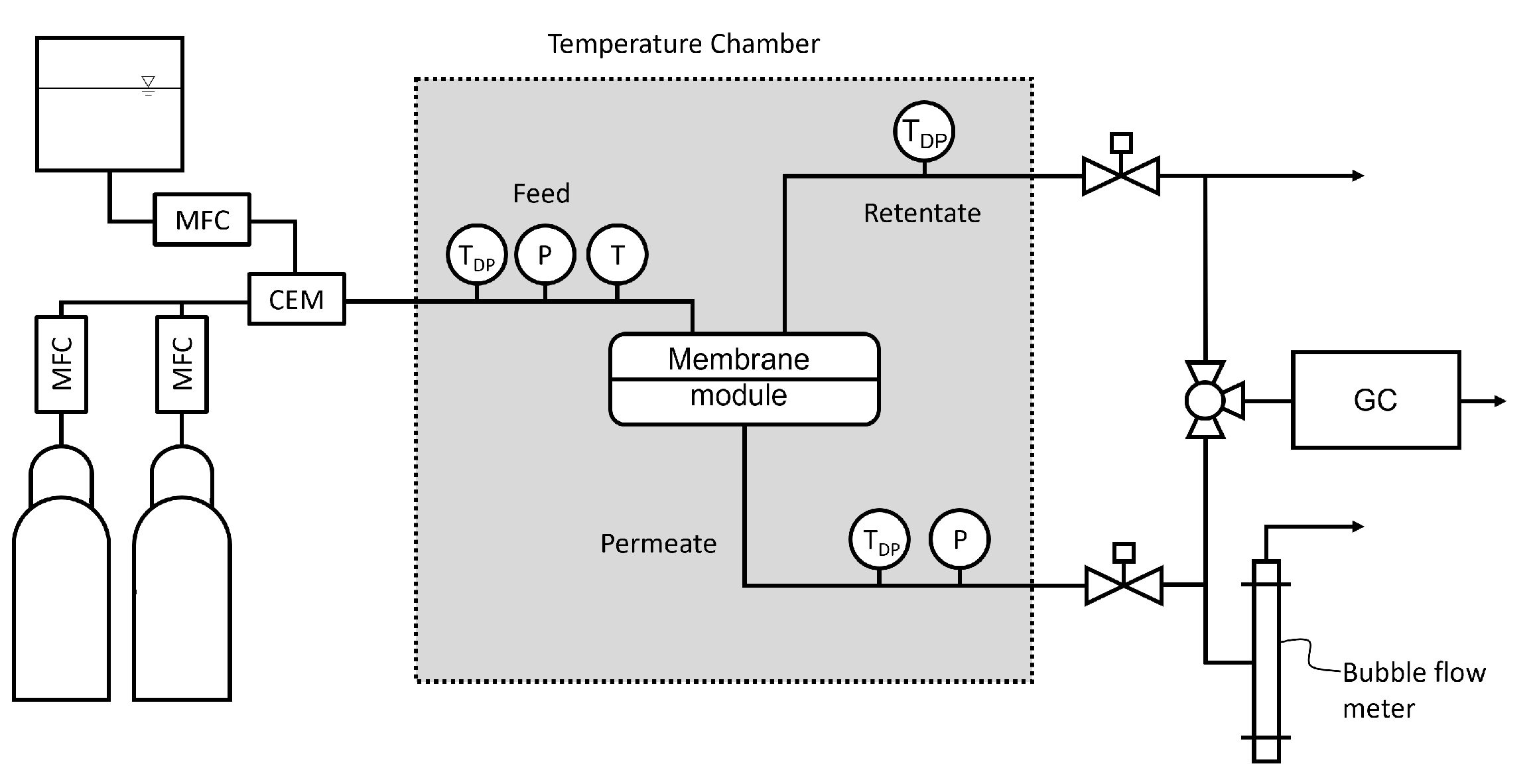
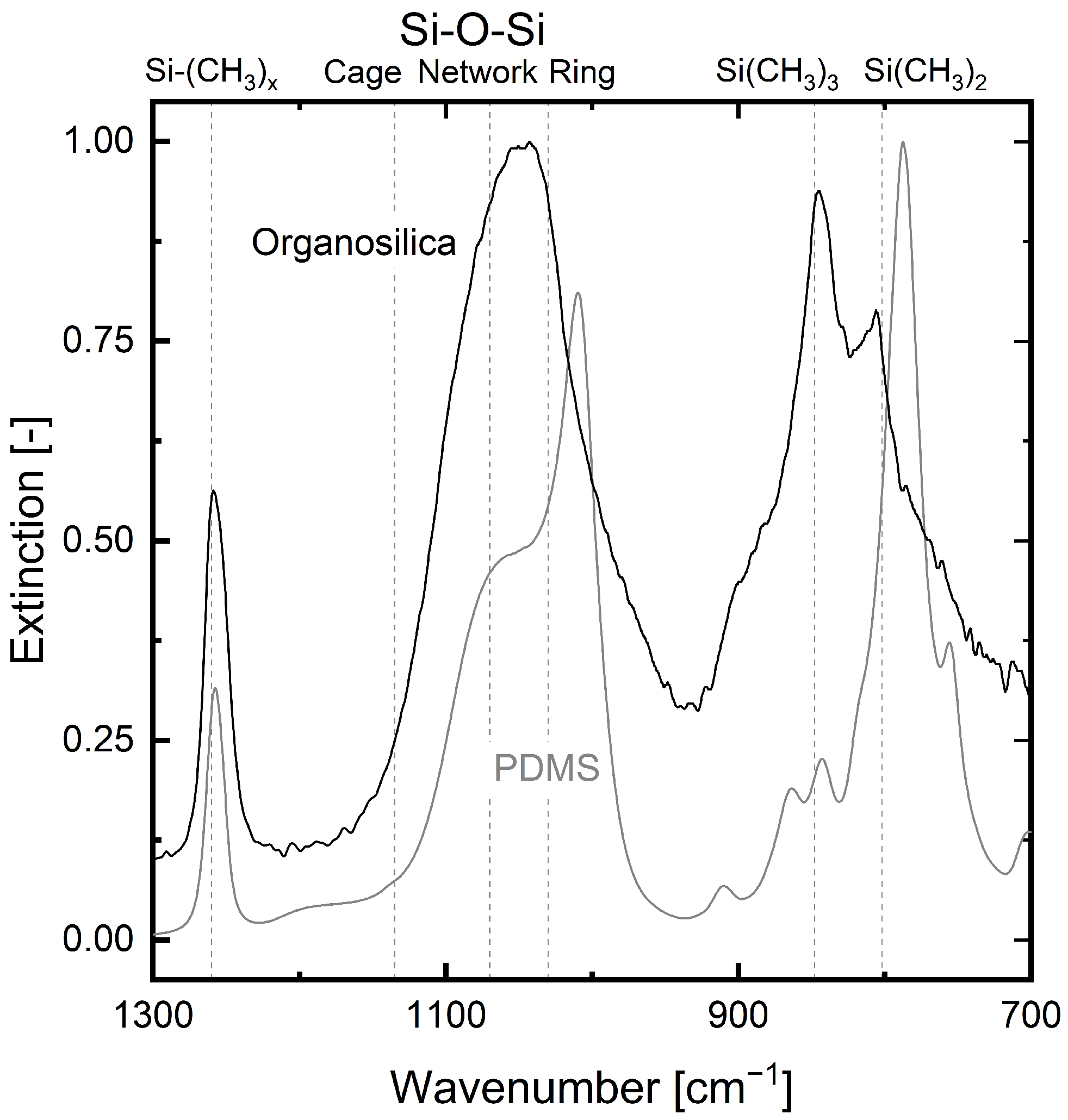
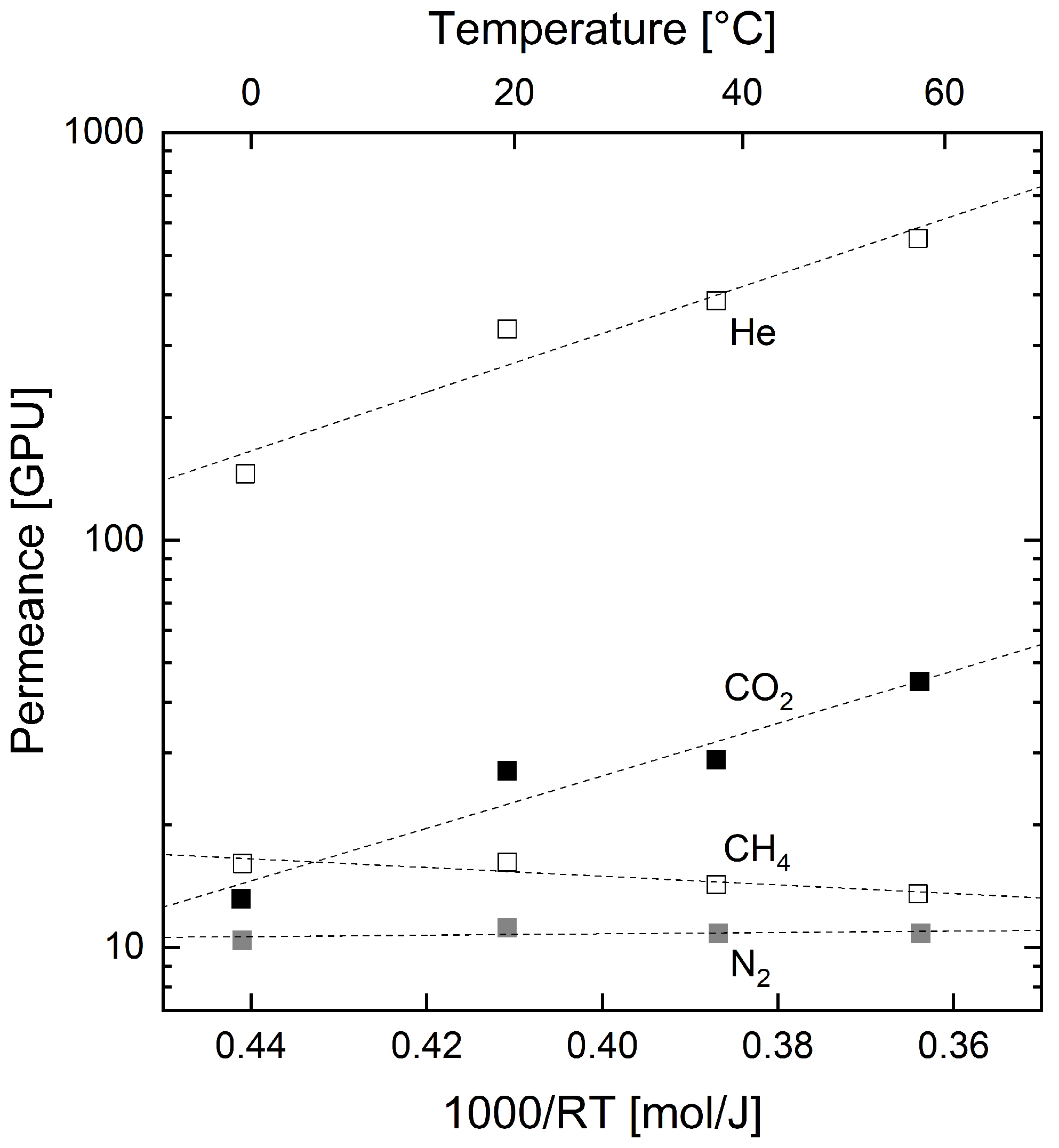
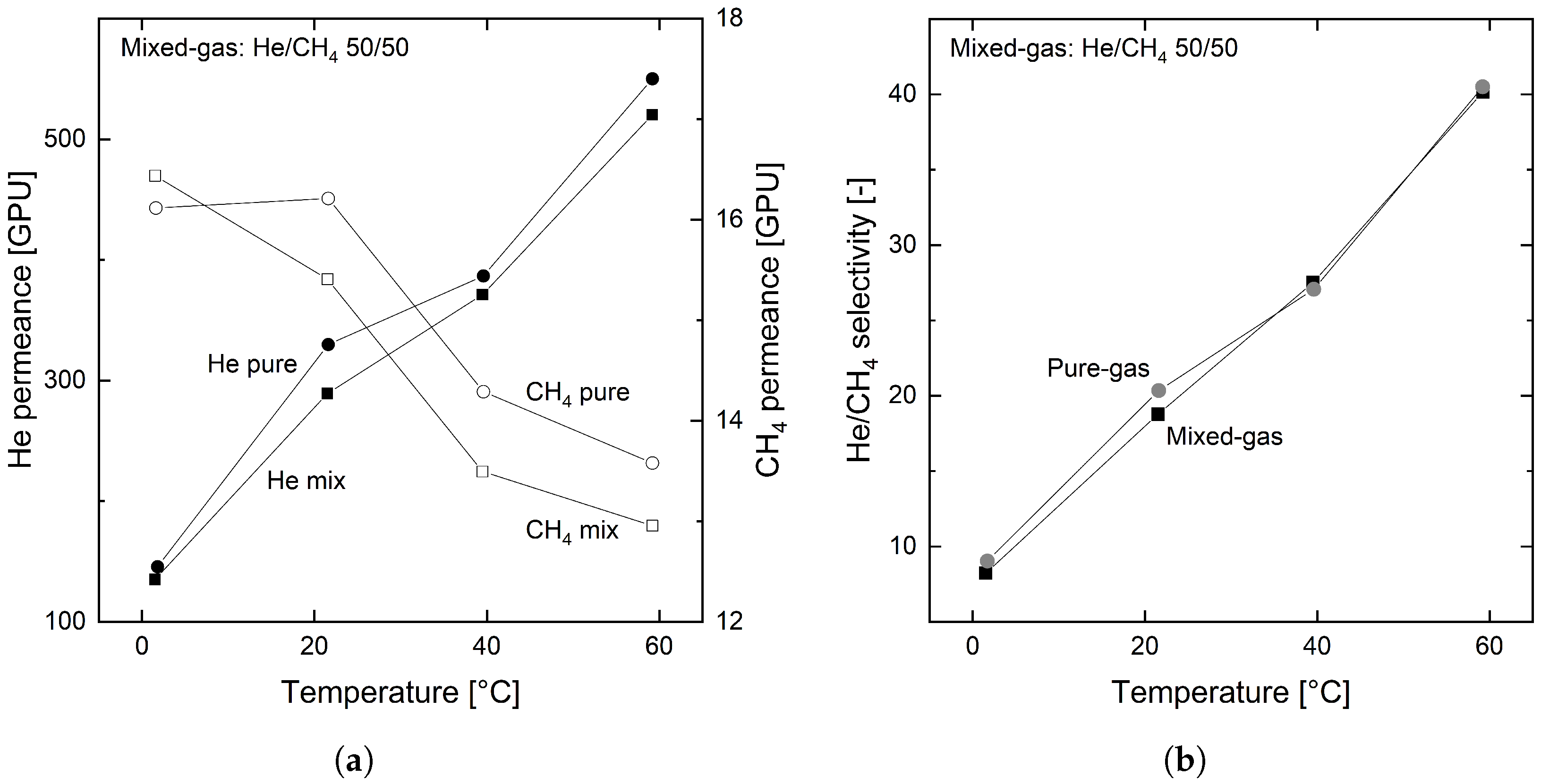
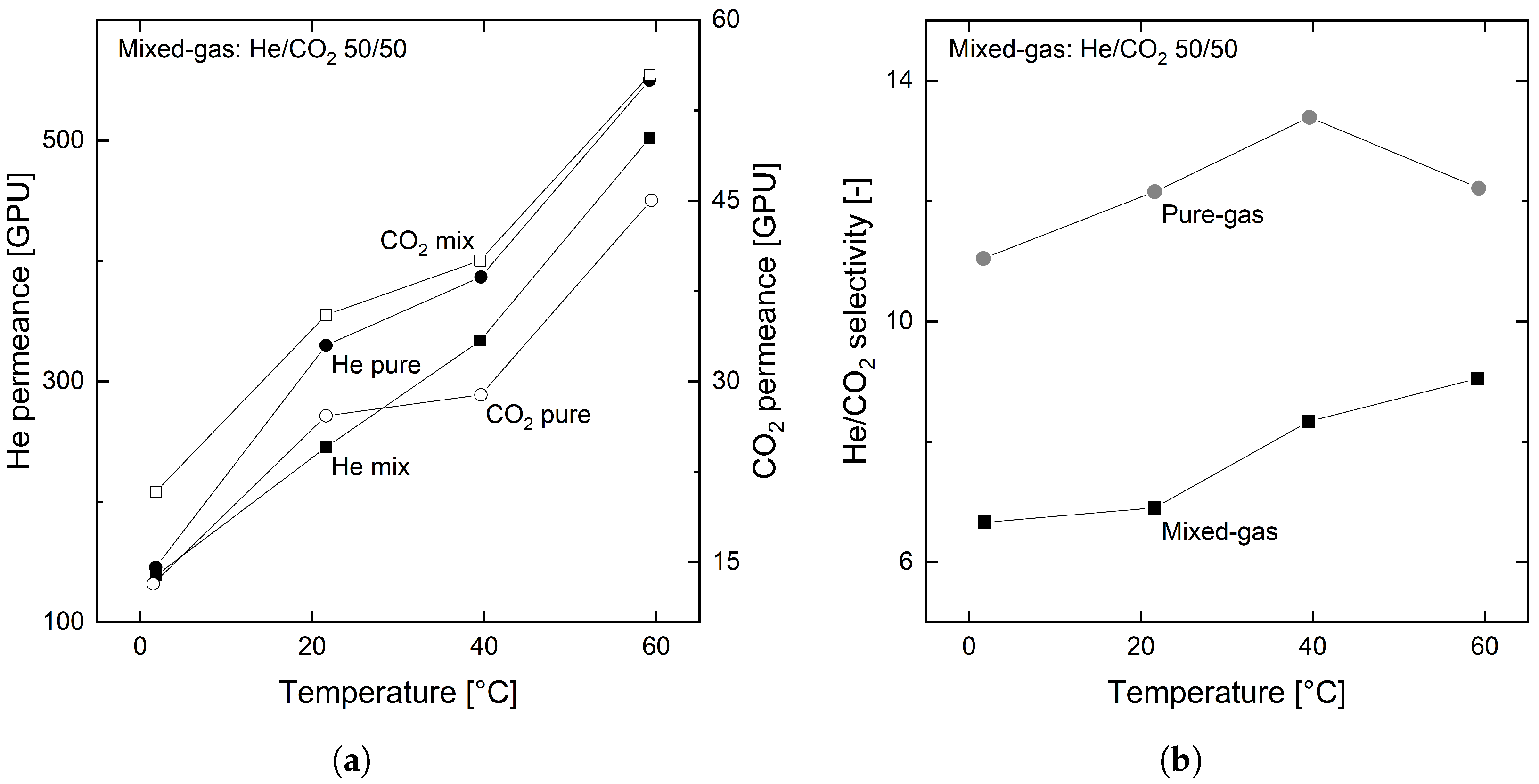
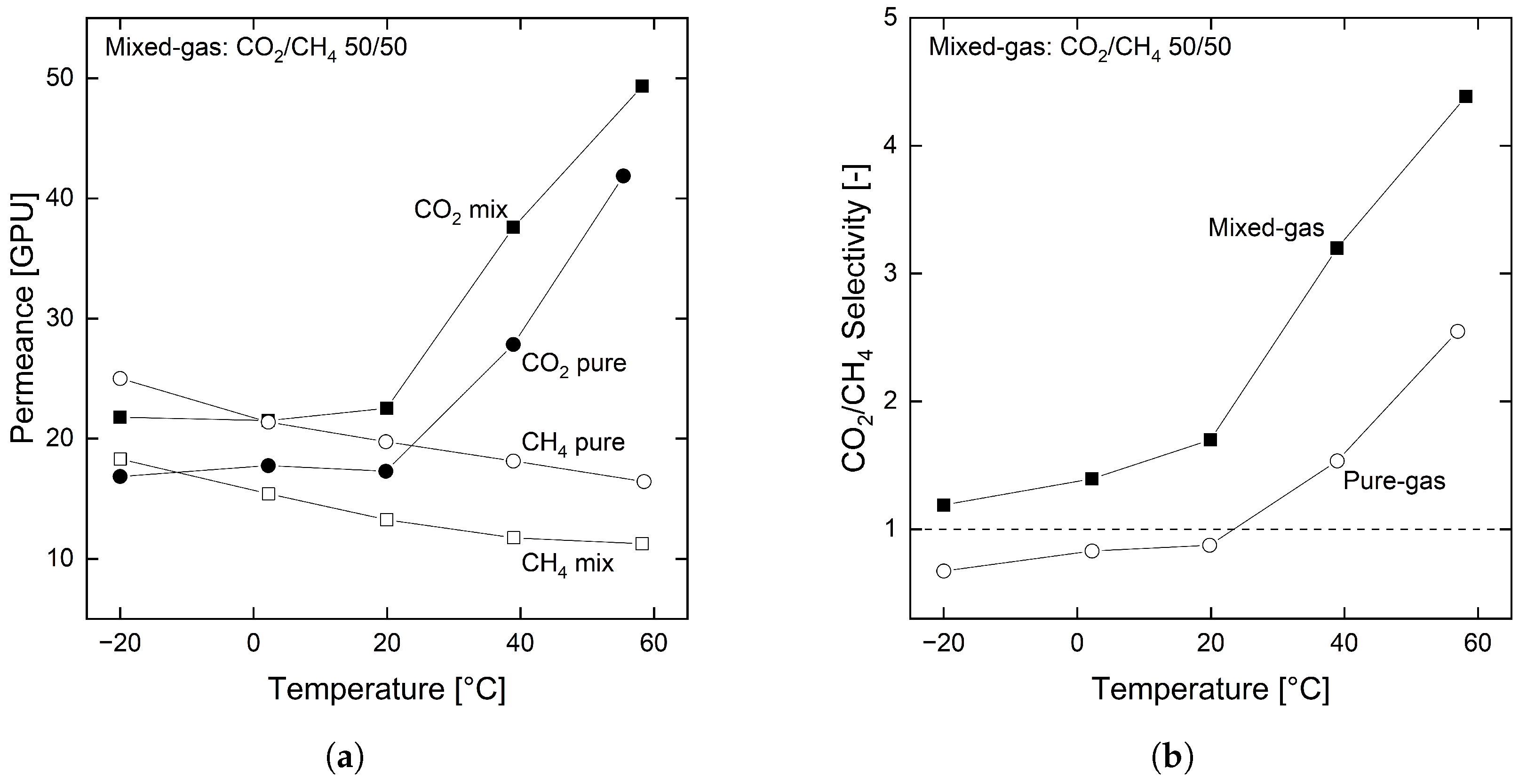
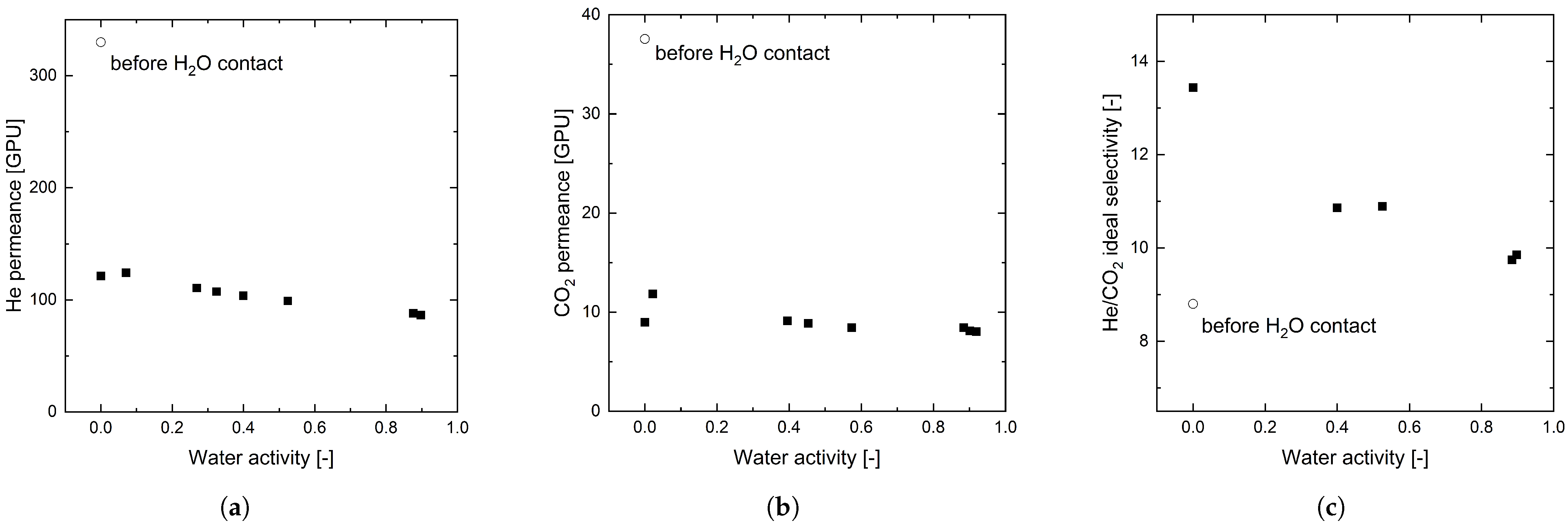

| Coating Type | HMDSO Flow [sccm] | Oxygen Flow [sccm] | Pulse on/off [ms] | Microwave Peak Power [W] | Coating Time [ms] | Thickness [nm] |
|---|---|---|---|---|---|---|
| Pre-Treatment | 0 | 100 | 4/45 | 4000 | 5000 | - |
| Layer Deposition | 70 | 0 | 2/45 | 2000 | 93,000 | ∼25 |
| Layer | Si2p | O1s | C1s | Composition |
|---|---|---|---|---|
| PDMS | 22.51 ± 0.18 | 25.11 ± 0.24 | 52.39 ± 0.38 | SiO1.1C2.3 |
| Organosilica | 24.95 ± 0.70 | 27.38 ± 0.13 | 47.67 ± 0.57 | SiO1.1C1.9 |
Publisher’s Note: MDPI stays neutral with regard to jurisdictional claims in published maps and institutional affiliations. |
© 2022 by the authors. Licensee MDPI, Basel, Switzerland. This article is an open access article distributed under the terms and conditions of the Creative Commons Attribution (CC BY) license (https://creativecommons.org/licenses/by/4.0/).
Share and Cite
Rubner, J.; Skribbe, S.; Roth, H.; Kleines, L.; Dahlmann, R.; Wessling, M. On the Mixed Gas Behavior of Organosilica Membranes Fabricated by Plasma-Enhanced Chemical Vapor Deposition (PECVD). Membranes 2022, 12, 994. https://doi.org/10.3390/membranes12100994
Rubner J, Skribbe S, Roth H, Kleines L, Dahlmann R, Wessling M. On the Mixed Gas Behavior of Organosilica Membranes Fabricated by Plasma-Enhanced Chemical Vapor Deposition (PECVD). Membranes. 2022; 12(10):994. https://doi.org/10.3390/membranes12100994
Chicago/Turabian StyleRubner, Jens, Soukaina Skribbe, Hannah Roth, Lara Kleines, Rainer Dahlmann, and Matthias Wessling. 2022. "On the Mixed Gas Behavior of Organosilica Membranes Fabricated by Plasma-Enhanced Chemical Vapor Deposition (PECVD)" Membranes 12, no. 10: 994. https://doi.org/10.3390/membranes12100994
APA StyleRubner, J., Skribbe, S., Roth, H., Kleines, L., Dahlmann, R., & Wessling, M. (2022). On the Mixed Gas Behavior of Organosilica Membranes Fabricated by Plasma-Enhanced Chemical Vapor Deposition (PECVD). Membranes, 12(10), 994. https://doi.org/10.3390/membranes12100994






